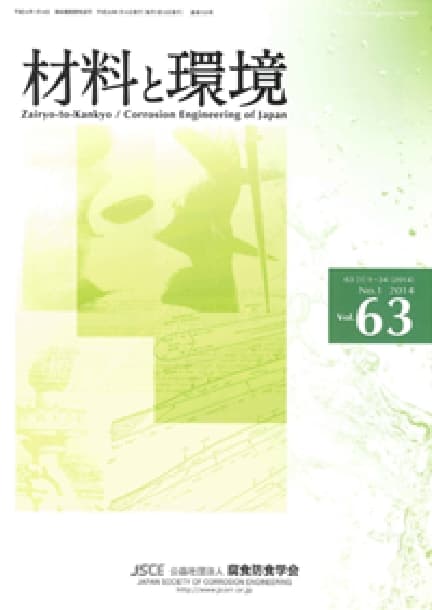- TOP
- Zairyo-to-Kankyo
- Vol. 73 (2024), No. 8
Zairyo-to-Kankyo Vol. 73 (2024), No. 8
Backnumber
-
Vol. 74 (2025)
-
Vol. 73 (2024)
-
Vol. 72 (2023)
-
Vol. 71 (2022)
-
Vol. 70 (2021)
-
Vol. 69 (2020)
-
Vol. 68 (2019)
-
Vol. 67 (2018)
-
Vol. 66 (2017)
-
Vol. 65 (2016)
-
Vol. 64 (2015)
-
Vol. 63 (2014)
-
Vol. 62 (2013)
-
Vol. 61 (2012)
-
Vol. 60 (2011)
-
Vol. 59 (2010)
-
Vol. 58 (2009)
-
Vol. 57 (2008)
-
Vol. 56 (2007)
-
Vol. 55 (2006)
-
Vol. 54 (2005)
-
Vol. 53 (2004)
-
Vol. 52 (2003)
-
Vol. 51 (2002)
-
Vol. 50 (2001)
-
Vol. 49 (2000)
-
Vol. 48 (1999)
-
Vol. 47 (1998)
-
Vol. 46 (1997)
-
Vol. 45 (1996)
-
Vol. 44 (1995)
-
Vol. 43 (1994)
-
Vol. 42 (1993)
-
Vol. 41 (1992)
-
Vol. 40 (1991)
Keyword Ranking
07 Jan. (Last 30 Days)
Zairyo-to-Kankyo Vol. 73 (2024), No. 8
Effects of Si in Water on Corrosion Behavior of Hot-dip Galvanizing
Koji Iwata, Shinichi Satoh
pp. 188-193
DOI:
10.3323/jcorr.73.188Abstract
Effects of temperature and concentration of silicate anion in water on corrosion behavior of hot-dip galvanizing were investigated by immersion test, surface analysis, and cross-sectional observation. Immersion test using ion-exchanging water indicated that the corrosion rate decreased due to deterioration of water quality. X-ray fluorescence analysis revealed that much more Si exist on surface of hot-dip galvanizing sample after immersion test using deteriorated water compared to clean water. Now we prepared corroding liquid by adjusting the concentration of silicate anion using distilled water and sodium silicate in order to confirm the effect of concentration of silicate anion on corrosion rate by immersion test. In this test, higher concentration of silicate anion led to lower corrosion rate as well as in the immersion test using ion-exchanging water. Moreover, the influence on the corrosion inhibition by silicate anion was larger in corroding liquid at 60℃ than at 25℃. Glow discharge optical emission spectrometry revealed that more Si existed in the corrosion products on surface of hot-dip galvanizing immersed in 60℃ than in 25℃ water, and the thickness of corrosion products containing Si was about 20-30 nm by cross-sectional SEM image.
Readers Who Read This Article Also Read
Zairyo-to-Kankyo Vol.73(2024), No.8
Visualization of Microscopic Hydrogen Diffusion in Polycrystalline Pure Ni Using an Ir Complex
Saya Ajito, Hiroshi Kakinuma, Motomichi Koyama, Eiji Akiyama
pp. 194-199
DOI:
10.3323/jcorr.73.194Abstract
Microscopic hydrogen visualization has long been required to clarify the hydrogen embrittlement mechanism of metallic materials. In this study, hydrogen diffusion depending on microstructure in polycrystalline pure nickel film was successfully visualized using an Ir complex, whose color changes with hydrogen. The hydrogen flux in nickel was found to be large at random grain boundaries and small inside grains and at coincidence site lattice grain boundaries.
Readers Who Read This Article Also Read
MATERIALS TRANSACTIONS Vol.64(2023), No.11
Zairyo-to-Kankyo Vol.73(2024), No.8
MATERIALS TRANSACTIONS Vol.45(2004), No.3
Effect of Diffusion Rate of Oxygen on Soil Corrosion and Evaluation of that in Soil
Kenta Fujihashi, Ryosuke Nakagami, Wataru Oshikawa
pp. 200-209
DOI:
10.3323/jcorr.73.200Abstract
Soil corrosion rate for architecture and civil engineering is regarded as 0.02 mm/year regardless of the soil. However, it is considered that corrosion rates of each soil are different because soil properties such as particle size, water content, chemical composition and pH are different. In this study, we measured dissolved oxygen diffusion coefficient of each soil and each water content and evaluated the charge transfer resistance of each dissolved oxygen concentration by AC impedance method, to investigate the effect of dissolved oxygen diffusion on soil corrosion.
Readers Who Read This Article Also Read
Zairyo-to-Kankyo Vol.73(2024), No.8
Zairyo-to-Kankyo Vol.73(2024), No.8
Article Access Ranking
07 Jan. (Last 30 Days)
-
Delayed Fracture Mechanism of 1700 MPa-Class Quenched and Tempered Bolt under Atmospheric Corrosion Environment
Tetsu-to-Hagané Advance Publication
-
Perspectives on the Promising Pathways to Zero Carbon Emissions in the Steel Industry toward 2050
ISIJ International Vol.65(2025), No.2
-
Effect of B on Surface Oxidation Behavior and Phosphatability of Si-Mn-added Cold-Rolled Steel Sheets
ISIJ International Advance Publication
-
From plasticity to fracture in pearlitic microstructures: Atomistic study of cementite thickness and deformation localization
ISIJ International Advance Publication
-
Processability and Microstructural Morphology of γ-Fe/Fe2Nb Two-Phase Eutectic Alloy Manufactured by Laser Powder Bed Fusion
Tetsu-to-Hagané Vol.112(2026), No.1
-
Growth, Removal, and Agglomeration of Various Type of Oxide Inclusions in Molten Steel
ISIJ International Advance Publication
-
Thermodynamic Reassessment and Phase Diagram Calculations of the Fe–P and Fe–C–P Systems
Tetsu-to-Hagané Advance Publication
-
Metallurgical Aspects on Interstitial Free Sheet Steel From Industrial Viewpoints
ISIJ International Vol.34(1994), No.1
-
Influence of Ni Impurity in Steel on the Removability of Primary Scale in Hydraulic Descaling
ISIJ International Vol.37(1997), No.3
-
Hydrogen Embrittlement in Titanium and Its Alloys
Zairyo-to-Kankyo Vol.60(2011), No.5
You can use this feature after you logged into the site.
Please click the button below.










